PGMOL and the Premier League are opening up discussions between the referee and the Video Assistant Referee (VAR) for key incidents this season. In the fifth instalment of “Match Officials: Mic’d Up”, Howard Webb, chief operating officer at PGMOL, the organisation that oversees the League’s match officials, discusses five incidents from the last four weeks.
Webb and Michael Owen go through the conversation between the match officials to give fans greater knowledge of how decisions are made. The officials on the pitch do not hear all the conversations from the VAR hub in Stockley Park.
The incidents covered are:
– West Ham’s penalty appeal v Sheff Utd
– Newcastle’s penalty after review v Bournemouth
– Sheff Utd’s disallowed goal v Brighton
– Harrison’s goal v Spurs
– Solanke’s goal v West Ham
West Ham’s penalty appeal against Sheff Utd
Incident: West Ham United defender Ben Johnson sends in a cross and Sheffield United’s Anel Ahmedhodzic and West Ham’s Jarrod Bowen both have a hold of each other.
What the match officials did: Referee Michael Salisbury awards a free-kick to Sheff Utd. After review the VAR confirms the on-field decision.
AD
CC
Audio description available
Owen: “Well, I thought that was a pen [penalty], but you don’t.”
Webb: “A lot of people did. A really important moment at the end of this tied game and when you watched that on the TV, it shows a replay that looks like the Sheffield United player isn’t looking at the ball and just kind of bowls into the attacker Bowen.
“When the VAR looked at that, knowing that the on-field decision by the referee was a free-kick to Sheffield United for a foul by Bowen. He sees quite clearly that the arm of Bowen is on the shoulder of Ahmedhodzic and pulls him towards the West Ham attacker and then they fall over.
“The Sheffield United player is actually looking at the ball most of the time. He’s trying to maintain his view on the ball, and he only can’t do that when he’s pulled by Bowen.
“So again, I think, looking at all of the angles that we had available, we were able to confirm the on-field decision as a foul to Sheffield United rather than the penalty a lot of people thought should have been given when they just watched it more casually on a TV broadcast.
“And don’t forget the on-field decision is important. The independent KMI panel that we put all of these incidents to, the Key Match Incident Panel, which has got lots of ex-players on it, looked at that and were unanimous that this was a correct decision and not a penalty for the action by Bowen of pulling the defender on to him and pulling them down.
Owen: “No, I’m not convinced. No. I still think it’s a penalty, looking at that.”
Webb: “He is square, isn’t he? He’s defending in the way that he’s meant to defend. He’s looking at the ball and yeah, there’s some jostling and that happens on most situations where balls are coming into the penalty area with players in close proximity, so we’re not too concerned about that.
“But then we do see, or I at least see, the arm coming on to the shoulder, which spins the player, off-balances him and brings him down and that’s what the on-field referee saw.
“From a VAR point of view, you look at that, you see what the referee’s seeing and you’re never going to see that as a clear-and-obvious error, not to give a penalty.
“In the cold-light-of-day analysis, the panel who looks at this also agreed with us unanimously.”
Owen: “Who are the panel? What’s their role?”
Webb: “The panel are a group of ex-players, high-level players and managers who come together every week to look at all of the key match incidents in the Premier League – the goals, the penalties, the red cards – and they give a verdict from their view and their lived experience as to whether or not the decision is correct.
“They also make a judgment on whether VAR correctly or didn’t correctly get involved.
“We value their independence. We value their experience in the game. It gives us guidance, and it’s been a successful implementation this season in the Premier League.”
Newcastle’s penalty after review against Bournemouth
Incident: A Newcastle United free-kick is sent towards the penalty area and Fabian Schar is pulled to the ground. There are multiple factors in this offence as Schar is stood in an offside position but does not impact play until after he is fouled.
What the match officials did: Referee Michael Salisbury does not believe the shirt pull on Schar is worthy of a penalty and the assistant referee Richard West then flags for offside.

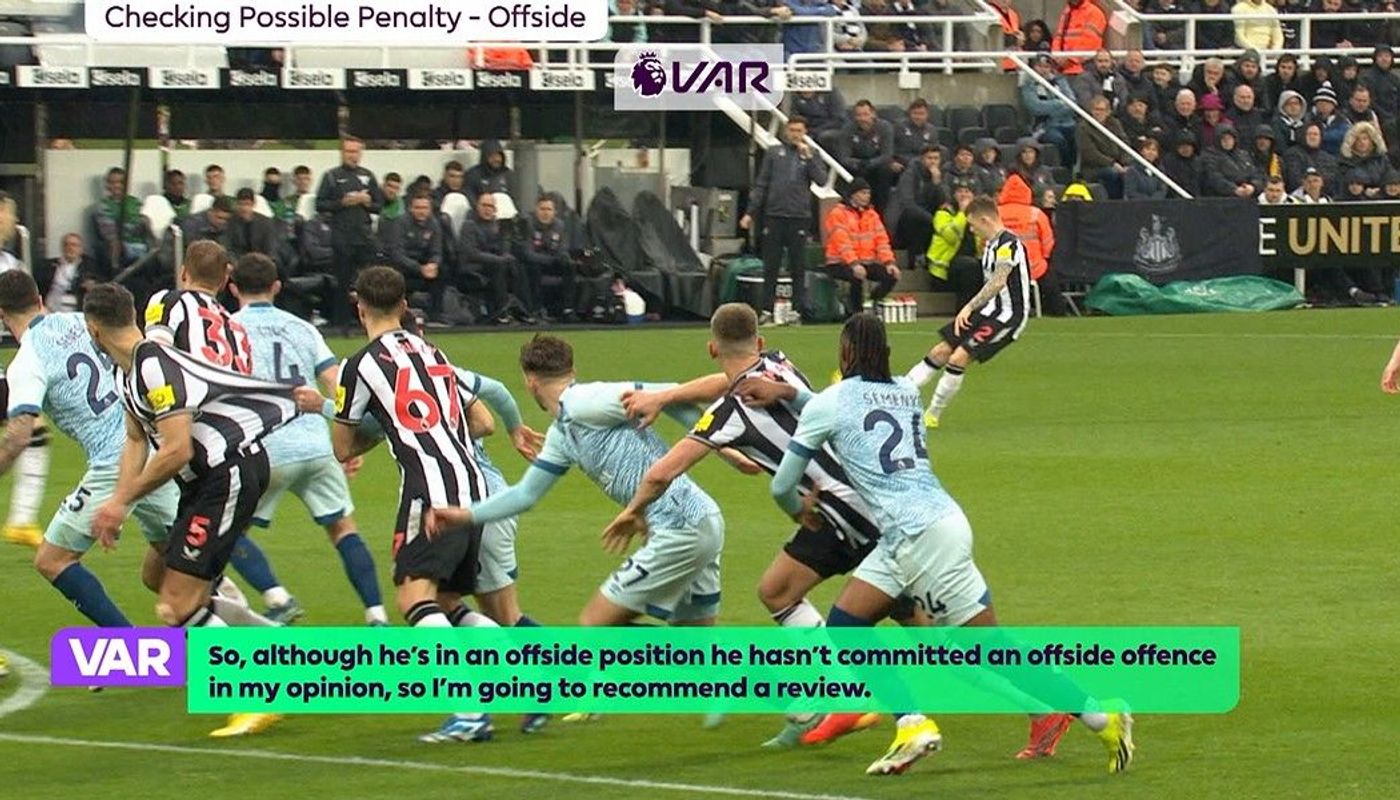
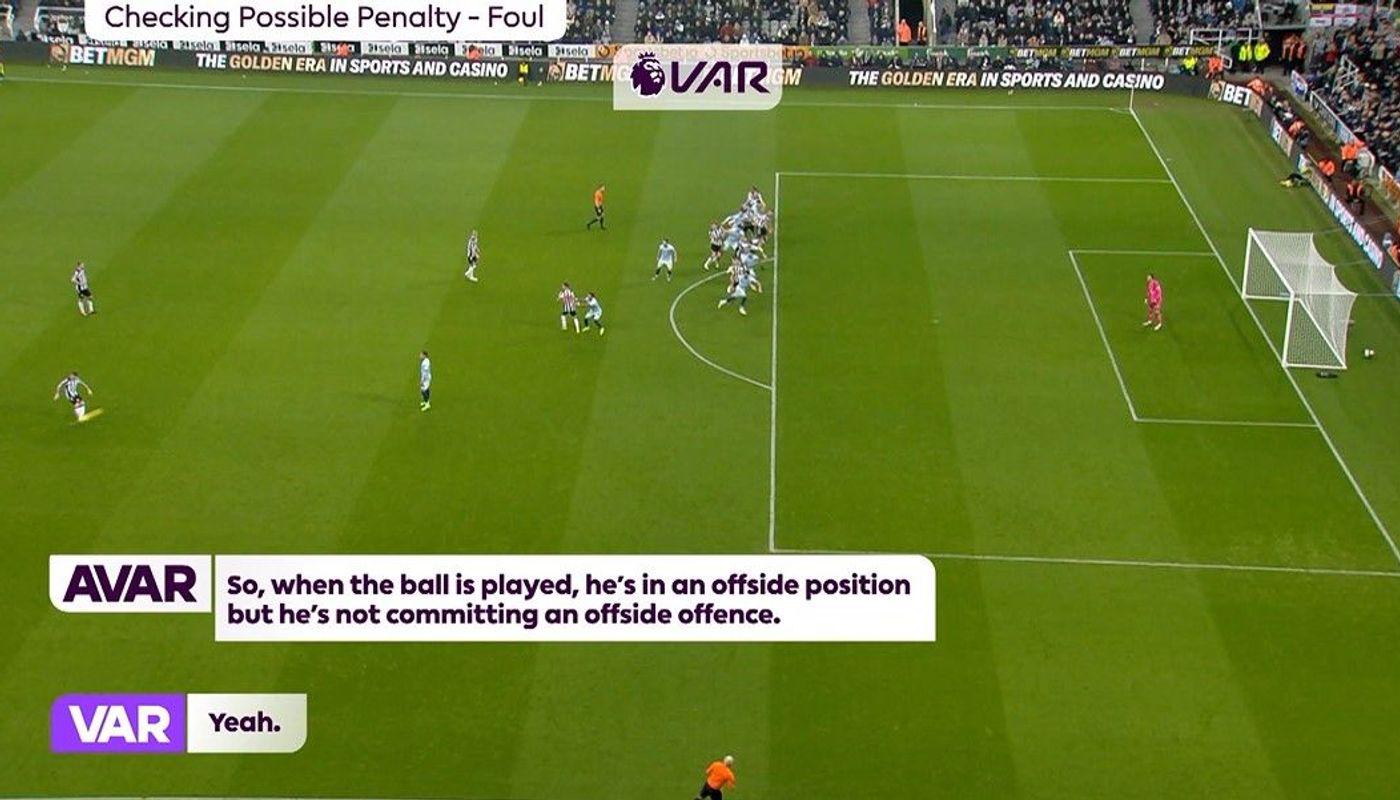

Owen: “Right, quite a complex decision that one. My gut feeling there is that it’s offside. You’re probably going to convince me otherwise. However, what’s the law, first of all?”
Webb: “I know that people have asked the question about why offside wasn’t penalised in this situation. However, the law specifically allocates some wording around this type of situation because for an offside offence to be committed the player in the offside position has to challenge for the ball or play the ball. Just being in an offside position itself isn’t necessarily an offence.
“The law stipulates that a player who’s in an offside position who’s moving towards the ball with the intention of playing the ball at some point, is then fouled by an opponent, prior to attempting to play the ball or challenging for the ball. It’s the foul that gets penalised because that occurred before the action by the attacker that would commit the offside offence and that’s exactly what we saw here.
“In this situation, the free-kick is taken. Fabian Schar is in an offside position. We know that, there’s no doubt about that.
“He starts moving towards goal and we see Adam Smith pull his shirt. The sustained holding offence, starts outside, continues inside.
“Now, we wouldn’t in normal circumstances flag as soon as the free-kick comes in. The assistant referee waits to see where the ball goes. Another Newcastle player might come in, from an onside position and head the ball towards goal so we wait to see where does the ball go.
“Does Schar get involved in the play by challenging for the ball when it’s in that dropping zone? He doesn’t do any of those things because he doesn’t have a chance to because he’s dragged down before the ball gets there.
“That action by Smith deprives Schar of being involved in a second phase, for example. So, if Sven Botman in this case comes in from behind, if he heads the ball towards goal, the ‘keeper saves it and, when he heads it, Schar’s behind the ball, he’s allowed to stay involved in play.
“He’s not allowed to do that because, in this situation Smith drags him down. So yes, we know he’s offside, but we wouldn’t normally flag it straightaway.
“We wait to see what happens. And we shouldn’t be forced into penalising the offside offence, just because Smith drags him to the floor. We’d always wait to see what Schar does in that position and we wouldn’t normally have our hand forced in the way that Smith is asking us to do here by dragging him to the floor.”
Owen: “We can see Schar …. in an offside position as you say. He’s in an offside position and the ball is kicked.
“Now the ball ends up going basically right where he was so, all of a sudden, I’m thinking, ‘He is interfering now.’ He doesn’t start pulling… he’s kicked it before he starts pulling him, so that’s the first offence.
“And the other thing is that he wouldn’t pull him back, if he was onside, he wouldn’t be pulling him back anyway.”
Webb: “He might, he might not do. But, at this point, we don’t know what Schar’s going to do in the situation.
“We don’t know exactly who’s going to get on the end of this ball. Imagine if we flagged immediately that the free-kick was taken, if we raise the flag you’d say, ‘What are you doing? You don’t know where the ball’s going. It could go to Botman.’
“Botman’s onside. He might score. So why are you penalising Schar? Why are you stopping this play in this moment?
“We see that happen all the time in the Premier League, where officials wait to see what happens.
“Schar might just stand, he might not continue moving forward. He might not get on the end of the ball. He’s not stopping anybody from playing the ball. He’s not challenging for the ball at that moment so he’s not actually committing an offside offence, he’s just in an offside position and that happens an awful lot in the Premier League.
“A lot of goals are scored with players in offside positions. So we have to wait to see what happens.
“While we’re waiting to see, with the ball a long way away, Smith drags him down to the floor committing an offence on Schar that stops him continuing being involved in that play.
“Now, of course, if the ball goes to Schar and he challenges Adam Smith when the ball’s there that’s an offside offence. We’d penalise that, that would take precedent over any holding offence.
“If the holding offence happens as he’s challenging for the ball, we’d give offside because he’s in the motion of challenging for the ball. But, at this point, he isn’t.
“The ball’s a long way away, we don’t know where exactly it’s going to go and it could be that Botman heads the ball, Schar’s behind the header.
“He’s allowed to stay involved in that play. But of course, he’s not here, because Smith has pulled him down and stopped him continuing to be involved so, I understand philosophically why people would make that argument.
“However, the law specifically stipulates that this is not an offensive offside in this moment because he’s just in an offside position, he’s not done anything and, if a player moving towards the ball in an offside position gets dragged back or fouled.
“In this situation, the first offence is the foul because the offside offence hasn’t yet happened. He’s not done anything in that position that we could penalise as officials.”
Sheff Utd’s disallowed goal against Brighton
Incident: Sheffield United score a goal from a corner, but before the ball finds the back of the net, the assistant referee calls for a foul by Ben Osborn on Brighton & Hove Albion goalkeeper Bart Verbruggen.
What the match officials did: The assistant referee calls for a foul as Osborn is holding Verbruggen’s arm and referee Stuart Attwell restarts play with a free-kick to Brighton. The VAR reviews the incident and instead overrules the foul. They then send Attwell to review the incident in the Referee Review Area (RRA). After review Atwell changes the on-field decision to a free-kick for Brighton for offside.
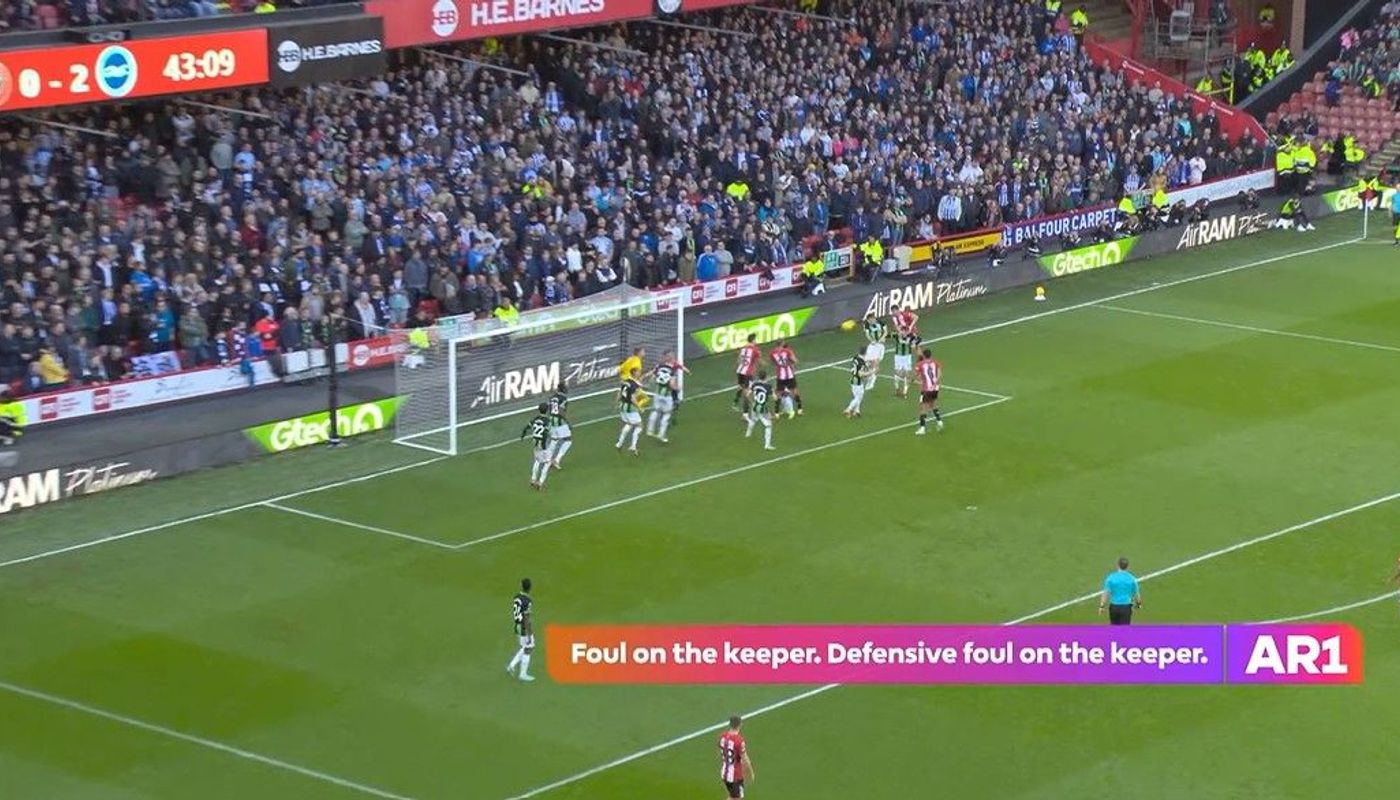

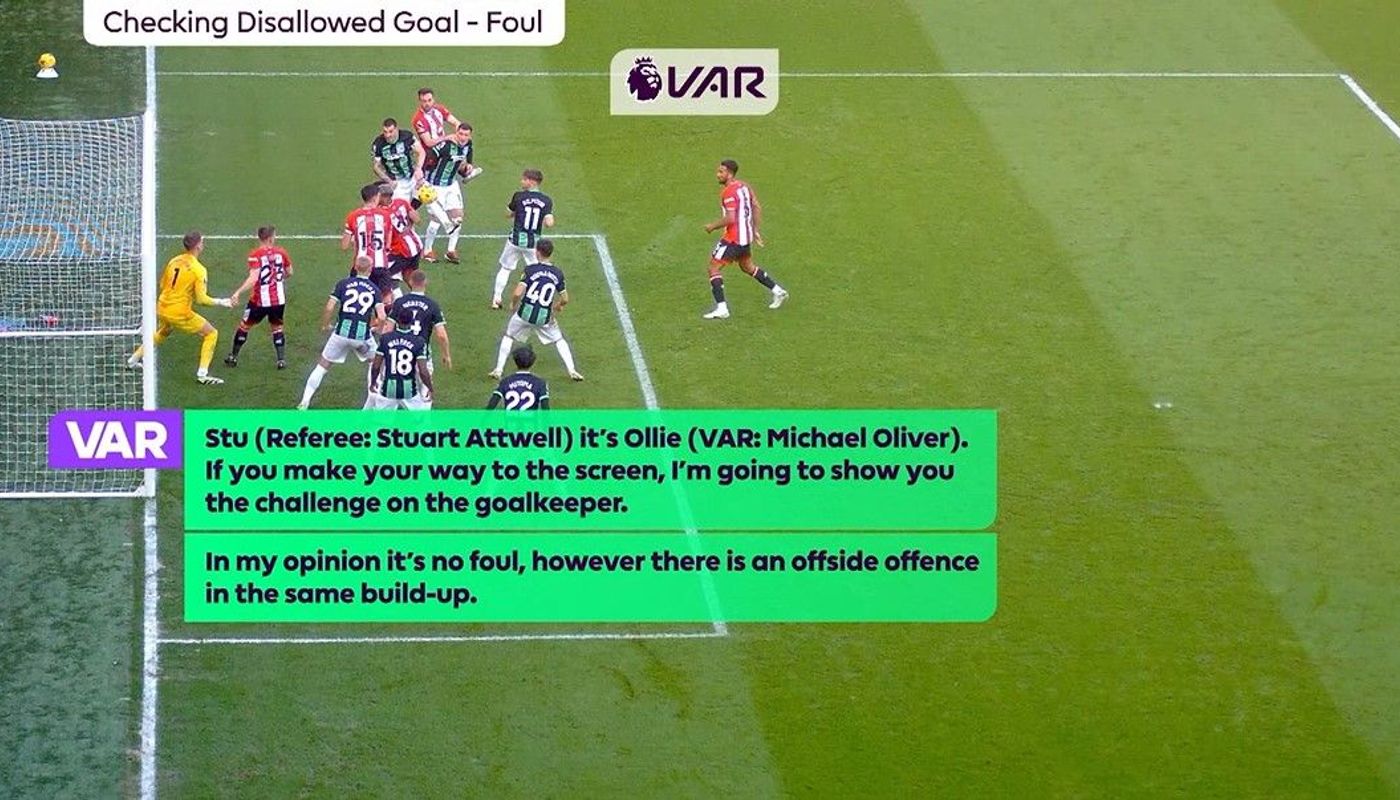

Owen: “Well, that’s an interesting one because obviously the on-field decision was something totally opposite to where they eventually got to, which was actually an offside.”
Webb: “It was. You’ll hear the on-field officials penalise Ben Osborn for what they perceive in real-time to be a foul on the goalkeeper.
“I think it’s the assistant referee on the far side who, on this set-piece has been given the specific responsibility by the referee of focusing on the goalkeeper because obviously, on a set-piece, there’s a lot to look at for a couple of officials there so they designate different areas of responsibility.
“He sees that coming-together. He thinks Osborn has grabbed hold of the goalkeeper’s arm and they penalise [him], but thankfully the referee holds his whistle until the ball’s in the back of the goal before penalising so that the VAR can then check whether or not there is actually that foul on the goalkeeper.
“When the VAR looks at it, he doesn’t really see anything that’s worthy of being penalised. He sees a bit of a coming-together, but then he sees the goalkeeper reset. He’s not really impacted by that and determines that’s not a foul.
“But, of course, we’re not only looking at that, we’re looking at the rest of the phase of play that leads up to that situation, including whether or not any players are in an offside position.
“When he looks at that, he sees that Ben Osborn is in an offside position when the ball is last played by a Sheffield United player. Yes, it hits Buonanotte before going to Osborn, but that’s only a deflection and therefore Osborn still is in an offside position, committing an offside offence right in front of the goalkeeper.
“I’m not sure if he gets the touch or whether it’s Ahmedhodzic that puts it in, but it doesn’t matter. It’s in front of the goalkeeper.
“He commits an offside offence and it’s rightly intervened upon by the VAR to confirm the disallowing of the goal, but for a different reason than the one that was actually given on the field.”
Owen: “We’re happy that that’s obviously not deliberate because that’s the key aspect, isn’t it?”
Webb: “It is, because if this was a deliberate play by Buonanotte then that would negate the offside position of Osborn. But it’s not, it hits him.
“He has no time to control his body movements, he’s not actually playing the ball, passing the ball. It just hits him and goes to him so that’s the deflection. It doesn’t negate the offside.
“In this situation, we still then send the referee to the screen because the on-field decision was subjective, a foul.
“It would have been a direct free-kick to the defence. There’s no foul but we send him to the screen to see that and then to also show them the offside.
“We restart with an indirect free-kick. So good process, good identification. If there had been no offside, I know the VAR would have intervened to have this goal awarded because he recognised a clear and obvious error in the first decision, the foul on the goalkeeper, which he doesn’t think exists.”
Harrison’s goal against Spurs
Incident: Everton centre-back James Tarkowski sends the ball across the box and Dominic Calvert-Lewin heads the ball towards goal and it comes off Jack Harrison before going into the net. Before the goal is scored, Tottenham Hotspur goalkeeper Guglielmo Vicario is sent to the ground after a challenge with Harrison.
What the match officials did: Referee Michael Oliver awards the goal. After review the VAR confirms the on-field decision.
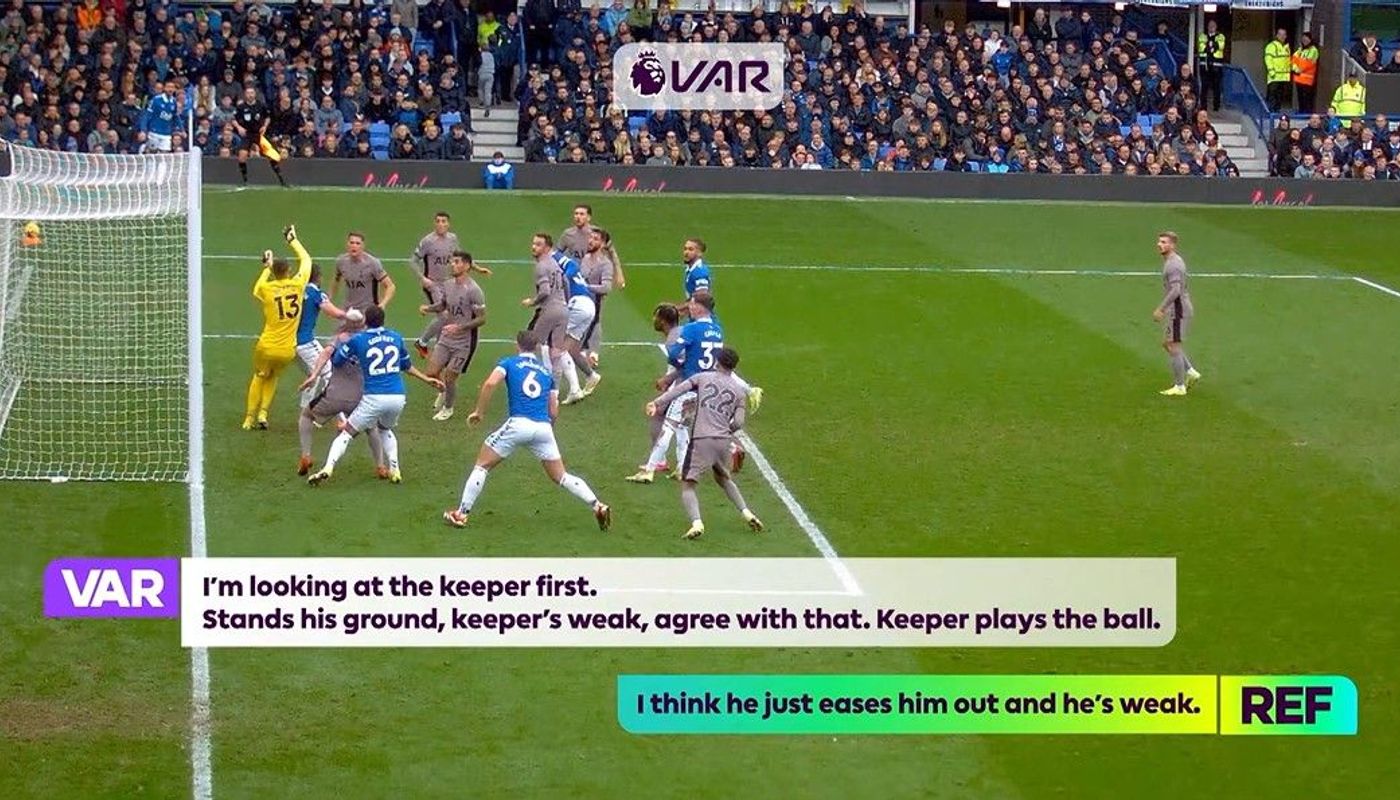
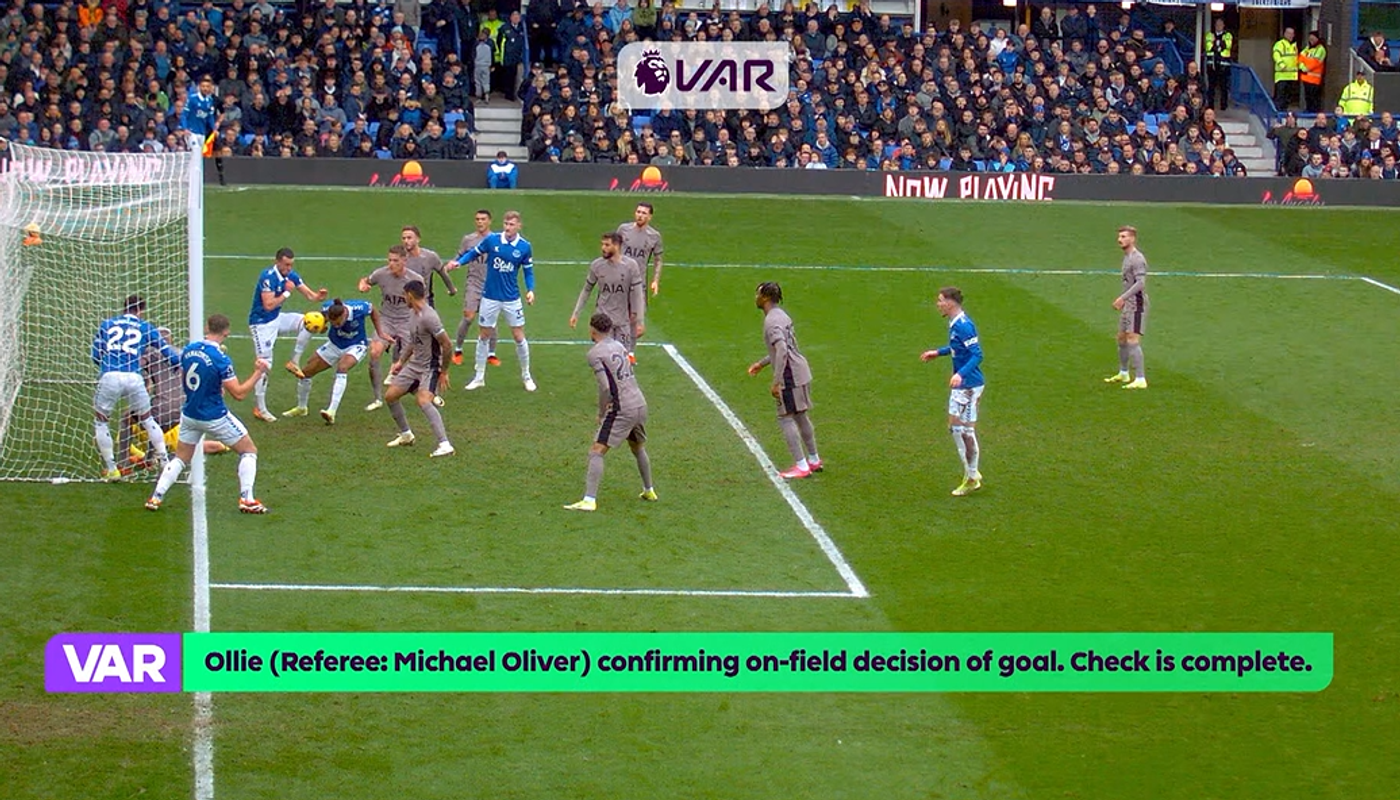
Owen: “Do you think that’s a foul or is it OK to be given?”
Webb: “I think this one’s just OK. We know that players are entitled to their space on the field. Jack Harrison’s entitled to his space just as much as Vicario is, as everybody else is.
“I think this is just OK. I think that he places his feet down. He might use his body a little bit. He doesn’t step clearly into the path of Vicario.
“He doesn’t usher him into the back of the goal. He doesn’t drag his arms, which is important for the goalkeeper, of course so I think this is just on the side of acceptability.
“We are seeing lots of tactics, you’re right, in and around set-pieces that we need to be aware of. We have analysts as well that help us stay ahead of the game with those things and one of the things that we’re always mindful of is the importance of the goalkeeper in set-pieces, as it’s the only player that can use his hands, so therefore he’s got a huge advantage.
“If people are trying to nullify goalkeepers, that can be really impactful, so we have to be careful and mindful of that. But I think this one is one that’s just on the right side of acceptability.
“Harrison’s entitled to his space, he uses a bit of strength, and I don’t see a clear action that takes the goalkeeper out.
“That impedes the goalkeeper in a way that I’d want to see if I wanted this to be penalised but we’re asking the on-field officials to deal with this first and foremost, necessarily rely on VAR because a lot of these are subjective calls.”
Solanke’s goal against West Ham
Incident: West Ham United midfielder Kalvin Phillips is dispossessed by AFC Bournemouth midfielder Ryan Christie and Dominic Solanke scores but is stood in an offside position.
What the match officials did: The assistant referee raises his flag for offside and referee Tim Robinson confirms the decision. After review the VAR tells Robinson to overturn the decision as the ball is played by Phillips and therefore Solanke is not offside. Robinson then awards a goal to Bournemouth.
Webb: “A good example of why VAR is so important at full speed. It does look like Ryan Christie plays that ball through to Solanke, doesn’t it? And the officials communicate to confirm that that’s what they’ve seen.
“You’ll hear on these clips how much more clearly the officials are communicating. You’ll hear the referee say the on-field decision is in this case ‘disallowed goal’.
“The VAR confirms that back so we know exactly what the starting point of the check is and when he looks at the video, he sees that clear movement by Kalvin Phillips and it obviously plays Solanke onside so we can give a goal back to the game.
“A really good example of the value of VAR in the Premier League.”
Glossary of terms
VAR: Video Assistant Referee; AVAR: Assistant Video Assistant Referee; RO: replay operator; APP: attacking phase of play.
UK users can watch the whole “Match Officials Mic-ed Up” video on Sky Sports and TNT Sports. International users can access the full video with their local rights-holder.
Also in this series
]
SourceLarose.VIP
